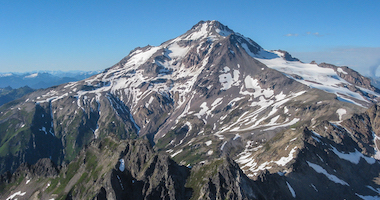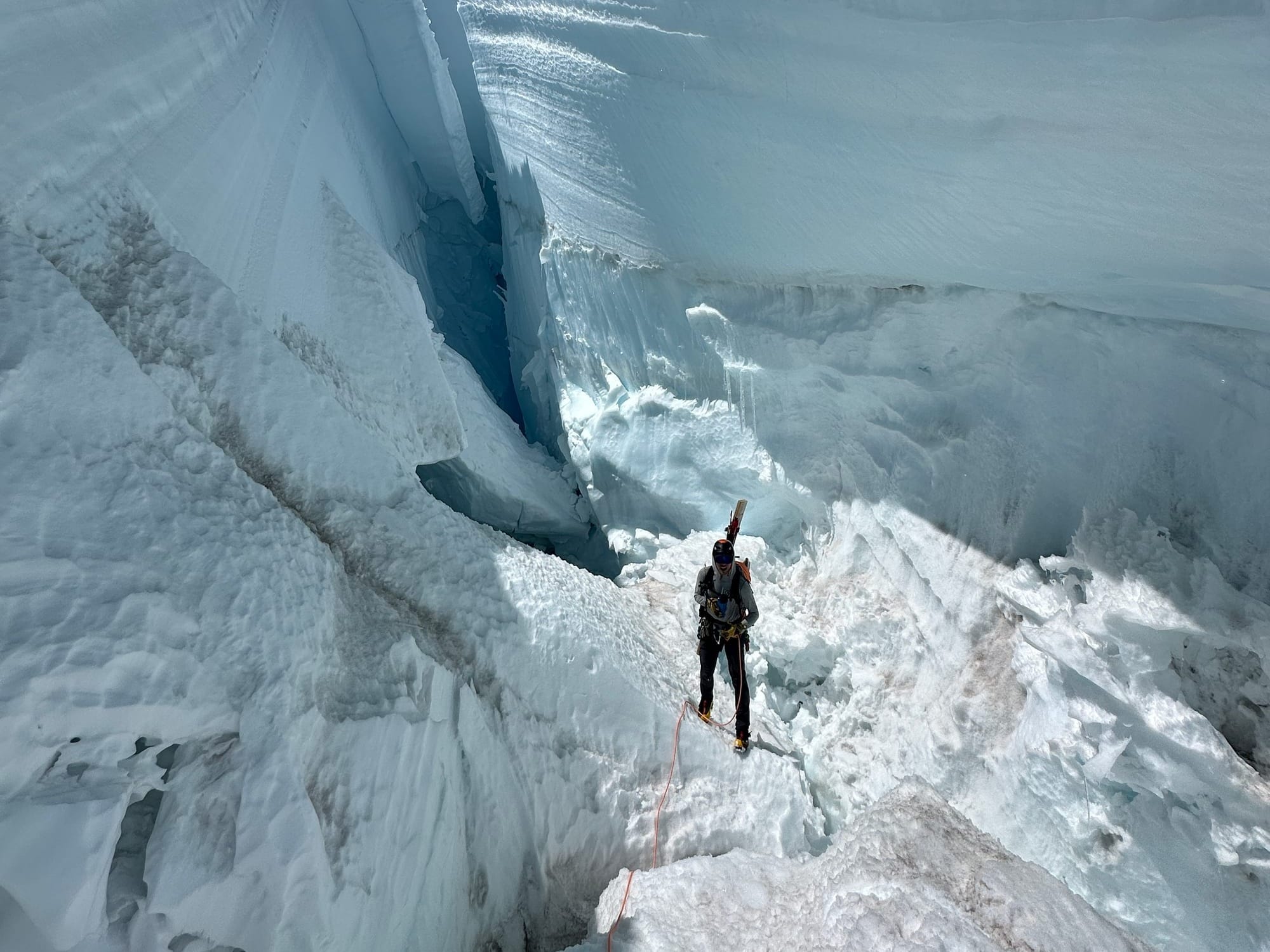In mountaineering, success isn’t just measured by tagging summits — it’s about returning safely, making good decisions under pressure, and preserving the space between what’s possible and what’s wise. We won’t ever be able to control precisely what happens in the mountains, or negate risk entirely, but we can hedge our bets with a proven tool, a margin of safety.
This margin of safety is what keeps climbers alive in unpredictable, high-consequence environments. Let’s look at what it means, how to create it on the mountain, and how RMI makes it the foundation of every climb.
What is a Margin of Safety?
At its core, a margin of safety is a buffer between capacity and risk. It’s the cushion you leave for error, bad luck, or the unexpected.
The concept is universal. Engineers call it a factor of safety — designing a bridge or skyscraper to withstand far more stress than it will ever face in normal use. Pilots don’t load just enough fuel to reach their destination; they carry reserves in case of delays or diversions. Surgeons plan procedures with contingencies for complications. Investors avoid putting all their capital into a single stock, keeping extra cushion to absorb shocks.
The principle is the same across disciplines: build in more than you think you need, because reality is unpredictable.
Mountains simply make the stakes more immediate. A margin of safety on a climb isn’t an abstract number on a blueprint or a balance sheet — it’s a decision that can mean the difference between coming home or not. On the mountain, this margin might look like setting an earlier turnaround time, carrying extra insulation in case of an unplanned bivy, or stopping short of the summit when the weather or snowpack erases your buffer.
Creating a Margin in the Mountains
Margins don’t appear by accident — they’re created through preparation, awareness, and choices in the moment. And the best way to understand them is to connect mountaineering examples to everyday industries where safety margins are more familiar.
Pacing
In climbing, moving too slowly eats away at your margin; energy, weather, and daylight are all finite resources. Guides make decisions in real time based on shifting conditions, the forecast, and the strength of the team.
Just like a pilot carries extra fuel, we aim to preserve a buffer of time and energy, not because we always expect to use it, but because the mountains often demand flexibility. Building and protecting that margin ensures enough capacity for a safe descent and recognizes that the summit is only one step in the bigger objective: returning safely.
Weather and Route Conditions
Snow bridges, rockfall, and storms are the mountain’s way of narrowing your buffer. Climbers who push ahead in deteriorating conditions are like drivers ignoring a “low fuel” light in the desert — technically possible to continue, but leaving no room for error. A margin of safety means recognizing when conditions have closed the gap too far and turning back before risk overtakes reason.
Gear and Preparation
Redundancy is margin. Carrying an extra headlamp, a backup layer, or a few hundred more calories than you expect can feel excessive until the climb takes longer than planned. In aviation, planes are built with multiple redundant systems for the same reason — if one fails, the backup prevents catastrophe. On the mountain, your “backup system” may be as simple as dry gloves or a second light source.
Team Dynamics and Group Safety
One climber’s condition can shift the margin for everyone. A fatigued rope-mate, poor pacing, or altitude issues can slow the group and increase exposure to hazards. In medicine, this is like a surgical team pausing a procedure if one member notices something wrong — the decision protects the patient, even if it means stepping back. While this can often mean a turnaround decision for a small climbing team, at RMI, we utilize our ratios and guide training to help as many climbers summit as possible, even if some need to turn around.
Decision-Making and Heuristics
One of the greatest threats to a margin of safety isn’t physical — it’s psychological. Ian McCammon’s landmark study on avalanche accidents revealed how heuristics (mental shortcuts) lead climbers into danger. The familiarity heuristic makes us trust terrain we’ve seen before, even if conditions are different. The commitment heuristic convinces us to keep going simply because we’ve already invested so much time and energy. These traps appear everywhere in life — like investors holding onto a failing stock because they’ve already “sunk” money into it. Recognizing these tendencies is the first step in countering them and preserving your safety buffer.
“I could see the summit up ahead and my hazy mental math told me that I would be there in less than two hours if I maintained the same pace. The only problem was that I hadn't felt my toes in quite some time and no amount of stomping or swinging my legs had helped. Without any other option, I got out my shovel, dug a human sized hole in the slope and climbed in. Taking off my boots, I massaged my numb feet, but the feeling just wouldn't come back. No matter how hard I rubbed the tips of my toes were still white.
I sat there trying to manifest feeling and convince my commitment-to-safety that two more hours wouldn't cost me my toes, but I knew the truth. After what felt like an eternity of internal struggle I put my boots back on, radioed my teammates and started to walk back down the ridge toward camp. That walk was one of the longest of my life. It wasn't just how slowly I moved, it was the pace of coming to terms with my decision- I was 43 days into my first Himalayan expedition and I turned around less than 100 vertical meters from the summit. The trip had cost most of my life savings, and the six months of hard training leading up to it had convinced me I was ready for the challenge. My climbing career had mostly been filled with summits, and it was the first time I ever had to make a decision of that scale.
I've turned around on plenty of climbs, for a multitude of reasons, in the years since then, but my mind often goes to that day when I'm weighing options. I'm still able to climb and guide with ten toes today because I made the hard, but correct choice that day.”- Eric Frank, RMI Guide
Adjusting Your Margin
Always remember that your required margins of safety can change from climb to climb; on climbs or in conditions with greater uncertainty, your margins should increase.
How RMI Creates Margins of Safety
At RMI, creating a margin of safety isn’t an afterthought — it’s built into every climb. While clients may not see the behind-the-scenes systems, they benefit from the discipline, culture, and training that underpin RMI’s operations.
Systems and Standards
RMI was the first guide service on Mount Rainier to implement an OSHA-recognized Safety Committee. We’ve also undergone and excelled in Washington Labor & Industries voluntary safety audits. These initiatives don’t just satisfy regulations — they demonstrate a culture where risk is managed proactively, not reactively.
Guide Training and Judgment
Every RMI guide goes through rigorous training in technical skills, but also in risk management and decision-making. They learn to recognize the subtle signs of hypothermia, altitude illness, or exhaustion in clients — often before clients notice it themselves. This foresight allows them to call for rests, pace adjustments, or even turnarounds before the margin of safety disappears.
Operational Practices
Margins are also built into our ratios, pacing, and route planning. RMI guides are empowered to make conservative calls when needed, prioritizing safety over summits. The expectation is not to squeeze out every possible vertical foot, but to preserve an appropriate safety margin for the team.
Culture of Safety
Being part of a High Reliability Organization means small errors aren’t ignored — they’re logged, learned from, and used to strengthen the system. At RMI, guides and supervisors foster a culture where raising concerns is encouraged, and the hard decision to turn back is respected as the hallmark of professionalism.
Why Margins Matter
Margins of safety don’t make climbs less adventurous — they make them more sustainable. Every climber eventually faces the choice between pressing on or turning back. The difference between tragedy and a story worth retelling often lies in how much margin you had when the decision came.
For RMI, those margins aren’t just abstract — they’re the reason our teams continue to climb safely, year after year. Because while summits are optional, coming home isn’t.
Sources
- McCammon, I. (2004). Heuristic traps in recreational avalanche accidents: Evidence and implications. Avalanche Review.
- Farnam Street. (2022). The Margin of Safety. https://fs.blog/margin-of-safety/
- Sierra Avalanche Center. (n.d.). Create Safety Margins. https://www.sierraavalanchecenter.org/create-safety-margins
- Wikipedia contributors. (2023). High reliability organization. https://en.wikipedia.org/wiki/High_reliability_organization
- Wikipedia contributors. (2023). Factor of safety. https://en.wikipedia.org/wiki/Factor_of_safety
- National Park Service. (n.d.). Mountaineering: Safety Tips. https://www.nps.gov














